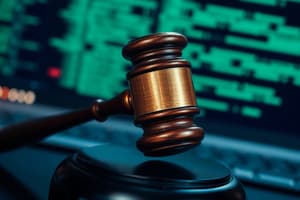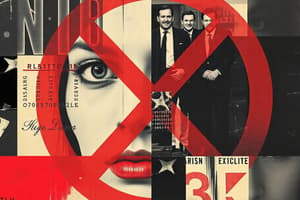Podcast
Questions and Answers
What was the main reason the Supreme Court struck down the Child Pornography Prevention Act in Ashcroft v. Free Speech Coalition?
What was the main reason the Supreme Court struck down the Child Pornography Prevention Act in Ashcroft v. Free Speech Coalition?
- It did not demonstrate a sufficient threat to children.
- It was ruled as overly broad and suppressed protected speech. (correct)
- It failed to consider community standards.
- It effectively criminalized derived artistic works.
The PROTECT Act aimed to address which of the following concerning child pornography?
The PROTECT Act aimed to address which of the following concerning child pornography?
- Criminalize virtual images indistinguishable from actual child pornography. (correct)
- Allow for leniency in prosecuting offenders.
- Disallow any form of artistic representation.
- Prevent the distribution of all pornography.
Which of the following correctly summarizes the four-prong test established in Central Hudson Gas & Electric v. Public Service Commission?
Which of the following correctly summarizes the four-prong test established in Central Hudson Gas & Electric v. Public Service Commission?
- Commercial speech must be not misleading and serve a government interest. (correct)
- Regulation must be more extensive than necessary to serve the interest.
- Government interests cannot restrict lawful activity.
- There must be a clear connection between the regulation and community impact.
What aspect did the U.S. Supreme Court express skepticism about in 44 Liquormart, Inc. v. Rhode Island?
What aspect did the U.S. Supreme Court express skepticism about in 44 Liquormart, Inc. v. Rhode Island?
Which legal act aimed to regulate payment systems for online gambling, recognizing a rise in illegal online activities?
Which legal act aimed to regulate payment systems for online gambling, recognizing a rise in illegal online activities?
What is a challenge concerning the protection of free speech under the First Amendment in relation to computer-related content?
What is a challenge concerning the protection of free speech under the First Amendment in relation to computer-related content?
Which case established that obscene material is not protected by the First Amendment?
Which case established that obscene material is not protected by the First Amendment?
What is one of the key components of the three-prong test established in Miller v. California?
What is one of the key components of the three-prong test established in Miller v. California?
What complicates determining obscenity in today's context?
What complicates determining obscenity in today's context?
What was a primary issue highlighted in the courts' lack of guidance regarding law enforcement and public policies?
What was a primary issue highlighted in the courts' lack of guidance regarding law enforcement and public policies?
What type of standards are used to evaluate obscenity according to community norms?
What type of standards are used to evaluate obscenity according to community norms?
Which of the following best summarizes the protection afforded by the First Amendment?
Which of the following best summarizes the protection afforded by the First Amendment?
What differentiates indecent speech from obscene speech regarding broadcasting?
What differentiates indecent speech from obscene speech regarding broadcasting?
Which act was designed to regulate communications in cyberspace while also criminalizing obscene communication to minors?
Which act was designed to regulate communications in cyberspace while also criminalizing obscene communication to minors?
What was a significant ruling made in the New York v. Ferber case concerning child pornography?
What was a significant ruling made in the New York v. Ferber case concerning child pornography?
What definition of scienter was established in Osborne v. Ohio?
What definition of scienter was established in Osborne v. Ohio?
What does the Child Pornography Prevention Act (CPPA) aim to address?
What does the Child Pornography Prevention Act (CPPA) aim to address?
What was the main concern regarding the accessibility of telephone communications and cable TV compared to other media?
What was the main concern regarding the accessibility of telephone communications and cable TV compared to other media?
What was deemed inadequate regarding the Miller v. California standard in the context of child pornography?
What was deemed inadequate regarding the Miller v. California standard in the context of child pornography?
Why was the Child Protection Act (CPA) significant in relation to previous legislation?
Why was the Child Protection Act (CPA) significant in relation to previous legislation?
What principle was emphasized regarding the advertising and selling of child pornography in legal rulings?
What principle was emphasized regarding the advertising and selling of child pornography in legal rulings?
What was a notable aspect of the court's ruling in New York v. Ferber regarding scientific and literary value of child pornography?
What was a notable aspect of the court's ruling in New York v. Ferber regarding scientific and literary value of child pornography?
The First Amendment protects text and images available on a computer from censorship.
The First Amendment protects text and images available on a computer from censorship.
The U.S. Supreme Court has provided clear guidance on all matters concerning computer-related crime.
The U.S. Supreme Court has provided clear guidance on all matters concerning computer-related crime.
Community standards are uniform across all regions when determining what is considered obscene.
Community standards are uniform across all regions when determining what is considered obscene.
The Miller v. California case established a three-prong test for determining obscenity.
The Miller v. California case established a three-prong test for determining obscenity.
Virtual images are always considered the same as real images in terms of obscenity.
Virtual images are always considered the same as real images in terms of obscenity.
Roth v. United States determined that obscene material is protected under the First Amendment.
Roth v. United States determined that obscene material is protected under the First Amendment.
There is a worldwide community on the internet that influences local standards of obscenity.
There is a worldwide community on the internet that influences local standards of obscenity.
The U.S. Supreme Court upheld the Child Pornography Prevention Act in Ashcroft v. Free Speech Coalition.
The U.S. Supreme Court upheld the Child Pornography Prevention Act in Ashcroft v. Free Speech Coalition.
The PROTECT Act prohibits virtual images that are similar to actual child pornography.
The PROTECT Act prohibits virtual images that are similar to actual child pornography.
The four-prong test established in Central Hudson Gas and Electric v. Public Service Commission applies only to advertisements that are misleading.
The four-prong test established in Central Hudson Gas and Electric v. Public Service Commission applies only to advertisements that are misleading.
The Old Wire Act of 1961 adequately addressed the challenges posed by the rise of online gambling.
The Old Wire Act of 1961 adequately addressed the challenges posed by the rise of online gambling.
There is a clear consensus among courts regarding the protection of technologically-generated images.
There is a clear consensus among courts regarding the protection of technologically-generated images.
Indecent speech can be broadcasted at any time, regardless of the audience composition.
Indecent speech can be broadcasted at any time, regardless of the audience composition.
The Telecommunications Reform Act of 1996 was entirely successful and upheld by the courts without any challenges.
The Telecommunications Reform Act of 1996 was entirely successful and upheld by the courts without any challenges.
The New York v. Ferber case established that there are no restrictions on the distribution of child pornography.
The New York v. Ferber case established that there are no restrictions on the distribution of child pornography.
Scienter in the context of child pornography law refers to a specific level of knowledge regarding the age of the subject.
Scienter in the context of child pornography law refers to a specific level of knowledge regarding the age of the subject.
The Child Pornography Prevention Act (CPPA) aims to criminalize virtual child pornography.
The Child Pornography Prevention Act (CPPA) aims to criminalize virtual child pornography.
Sable Communications, Inc. v. FCC recognized that telephone communications enjoy lower levels of protection compared to television.
Sable Communications, Inc. v. FCC recognized that telephone communications enjoy lower levels of protection compared to television.
The court determined that the Miller test is a satisfactory solution for regulating child pornography.
The court determined that the Miller test is a satisfactory solution for regulating child pornography.
The use of children in pornographic materials was deemed harmful to their physiological, emotional, and mental health.
The use of children in pornographic materials was deemed harmful to their physiological, emotional, and mental health.
Osborne v. Ohio specifically upheld the possession and viewing of child pornography.
Osborne v. Ohio specifically upheld the possession and viewing of child pornography.
The Supreme Court's opinion on child pornography focused on the potential harm to children and did not cite scientific or literary value as a justifying factor.
The Supreme Court's opinion on child pornography focused on the potential harm to children and did not cite scientific or literary value as a justifying factor.
Flashcards
First Amendment's protection
First Amendment's protection
Protects freedom of speech, including text and images on computers, against censorship.
Obscenity's definition
Obscenity's definition
What constitutes obscene material is influenced by community standards and is harder to define in the digital age.
Miller v. California test
Miller v. California test
A three-part test to determine if material is obscene: average person's perspective; patently offensive sexual conduct; lacks serious value.
Community Standards
Community Standards
Signup and view all the flashcards
Roth v. United States
Roth v. United States
Signup and view all the flashcards
Regina v. Hicklin
Regina v. Hicklin
Signup and view all the flashcards
Technology-specific laws
Technology-specific laws
Signup and view all the flashcards
FCC v. Pacifica Foundation
FCC v. Pacifica Foundation
Signup and view all the flashcards
Indecent speech vs. obscenity
Indecent speech vs. obscenity
Signup and view all the flashcards
Telecommunications Reform Act (CDA)
Telecommunications Reform Act (CDA)
Signup and view all the flashcards
Protection of Children Against Sexual Exploitation Act (1977)
Protection of Children Against Sexual Exploitation Act (1977)
Signup and view all the flashcards
New York v. Ferber
New York v. Ferber
Signup and view all the flashcards
Child Pornography Prevention Act (CPPA)
Child Pornography Prevention Act (CPPA)
Signup and view all the flashcards
Scienter
Scienter
Signup and view all the flashcards
Osborne v. Ohio
Osborne v. Ohio
Signup and view all the flashcards
Compelling government interest
Compelling government interest
Signup and view all the flashcards
Generalized victim
Generalized victim
Signup and view all the flashcards
Ashcroft v. Free Speech Coalition ruling
Ashcroft v. Free Speech Coalition ruling
Signup and view all the flashcards
PROTECT Act
PROTECT Act
Signup and view all the flashcards
UIGEA (Unlawful Internet Gambling Enforcement Act)
UIGEA (Unlawful Internet Gambling Enforcement Act)
Signup and view all the flashcards
Central Hudson test
Central Hudson test
Signup and view all the flashcards
Balancing Free Speech and Child Protection
Balancing Free Speech and Child Protection
Signup and view all the flashcards
Community Standards and Obscenity
Community Standards and Obscenity
Signup and view all the flashcards
Regina v. Hicklin (1868) and Obscenity
Regina v. Hicklin (1868) and Obscenity
Signup and view all the flashcards
Roth v. United States (1957)
Roth v. United States (1957)
Signup and view all the flashcards
Miller v. California (1973) Test
Miller v. California (1973) Test
Signup and view all the flashcards
Ambiguous Public Policies
Ambiguous Public Policies
Signup and view all the flashcards
First Amendment's Free Speech Protection
First Amendment's Free Speech Protection
Signup and view all the flashcards
Indecent Speech
Indecent Speech
Signup and view all the flashcards
Obscenity
Obscenity
Signup and view all the flashcards
Child Pornography
Child Pornography
Signup and view all the flashcards
Ferber Test
Ferber Test
Signup and view all the flashcards
Virtual Child Pornography
Virtual Child Pornography
Signup and view all the flashcards
CPPA (Child Pornography Prevention Act)
CPPA (Child Pornography Prevention Act)
Signup and view all the flashcards
Ashcroft v. Free Speech Coalition
Ashcroft v. Free Speech Coalition
Signup and view all the flashcards
Compelling State Interest
Compelling State Interest
Signup and view all the flashcards
Study Notes
First Amendment and Computer-Related Crime
- First Amendment protects free speech, including online text and images.
- Courts and legislation struggle to balance this protection with potential harm, particularly to children.
- Technology-specific laws often lack clarity, making it difficult to apply them fairly.
- Supreme Court rulings are scarce, providing limited guidance to law enforcement.
Obscenity and Community Standards
- Community standards vary in defining obscenity, particularly in a globalized online environment.
- Virtual images differ from real images, complicating their classification.
- Traditional notions of decency, as established through cases like Regina v. Hicklin, Roth v. United States, and Miller v. California, grapple with these complexities.
Defining Child Pornography
- Miller v. California's three-pronged test has influenced child pornography laws, but it's not always sufficient.
- New York v. Ferber: Supreme Court recognized distinct harm in using children for pornography, allowing stricter regulations.
- Osborne v. Ohio: Defined "scienter" as a degree of recklessness in child pornography cases, upholding Ferber.
- Ashcroft v. Free Speech Coalition: Supreme Court invalidated the Child Pornography Prevention Act (CPPA) for being too broad, protecting virtual child pornography.
Technology-Specific Legislation
- The Communications Decency Act (CDA) attempted to regulate online content but was deemed overbroad.
- The Child Protection Act (CPA) and its later amendments simplified requirements for prosecuting child pornography but had issues.
- The PROTECT Act aimed to address loopholes in prior laws.
Internet Gambling
- The Wire Act of 1961's language is insufficient to address online gambling.
- The Unlawful Internet Gambling Enforcement Act (UIGEA) focused on payment systems for online gambling.
- The Supreme Court's Central Hudson Gas & Electric and Posadas de Puerto Rico cases offer guidance on regulating commercial speech, impacting internet gambling.
Future Issues
- Balancing free speech rights with the need to protect children online remains a challenge.
- Questions linger on the treatment of technologically-generated or altered images concerning children.
Studying That Suits You
Use AI to generate personalized quizzes and flashcards to suit your learning preferences.




